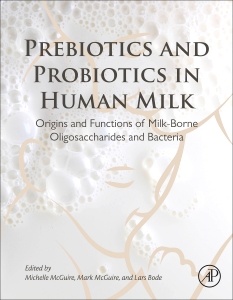Description
Prebiotics and Probiotics in Human Milk
Origins and Functions of Milk-Borne Oligosaccharides and Bacteria
Coordinators: McGuire Michelle, McGuire Mark A, Bode Lars
Language: English
Subjects for Prebiotics and Probiotics in Human Milk:
Keywords
Allergy; Anthropology; Antiadhesives; Are human milk; Bacteria; Beneficial microbes; Bifidobacteria; Bifidobacterium; Bifidus factor; Blood types; Blood; Breastfeeding; Cesarean -section; Chemical synthesis; Comparative biochemistry; Corynebacterium; Culture-dependent technique; Dendritic cells; DGGE; Diet; Domestic farm animal milk oligosaccharides; Dysbiosis; Eco-homeorhesis; Enteric bacteria; Enteromammary pathway; Environment; Enzymatic synthesis; Epi-holobiont; Evolution of milk oligosaccharides; Feces; Fermentation process; Genomics; Gestational age; GI tract; Glycan; Glycobiology; Gut inflammation; Gut; History; HMO history; HMO; Host�microbial interactions; human microbiome; Human milk microbiome; Human milk microbiota; Human milk oligosaccharide; Human milk oligosaccharides; Human milk; Immunity; In vivo13C-labeling; Infant nutrition; Infant; Infants; Infection; Lactation; Lactobacilli; Lactobacillus bifidus; Lactobacillus; Lewis antigens; Location; Mastitis; Metabolism; Microbiome; Microbiota; microbiota; Milk glycans; Milk microbiota; Milk oligosaccharide structures; Milk oligosaccharides; Milk; Next generation sequencing; Nonhuman mammals; Nonlactating; Obesity; Oligosaccharide; Oligosaccharides; Oral cavity; Passive immunity; perinatal intervention; Potential industrial utilization of milk oligosaccharides; Prebiotics; Prevention; Probiotic; Probiotics; RT-qPCR; Skin; Staphylococcus; Starter cultures; Streptococcus; Translocation; Urine
506 p. · 19x23.3 cm · Hardback
Description
/li>Contents
/li>Biography
/li>Comment
/li>
Prebiotics and Probiotics in Human Milk: Origins and Functions of Milk-Borne Oligosaccharides and Bacteria provides a comprehensive, yet approachable, treatise on what is currently known about the origins and functions of human milk oligosaccharides (HMO), the complex sugars in milk that are not digested by the infant.
The book examines how HMOs and bacteria in human milk may function independently and coordinately to influence both maternal and infant health. Human milk is the only food ?designed specifically to nourish humans, indeed representing the essence of a perfect ?functional food. And although researchers have been studying its composition for decades, surprisingly little is really understood about the origins and functions of its myriad components, an area that is especially true for HMOs and bacteria.
This book provides a thorough review of the newest research on these inter-related milk constituents as written by a team of experts from both academia and industry who actively conduct HMO and human milk microbiome research as they endeavor to apply this new knowledge to infant nutrition. Each chapter provides objective rationale for what research is still needed in this rapidly evolving area, also discussing the challenges and opportunities faced by the industry in adding HMO and microbes to infant food products.
This book is a valuable resource for nutrition researchers focused on infant nutrition, food scientists and product developers working on infant formula, and clinicians interested in broadening their understanding of the benefits of human milk for infants.
Section A. Background, Structures, Synthesis, and Analysis
Chapter 1. From Bifidus Factor to Human Milk Oligosaccharides: A Historical Perspective on Complex Sugars in Milk
Chapter 2. Structures, Classification, and Biosynthesis of Human Milk Oligosaccharides
Chapter 3. Oligosaccharides in the Milk of Other Mammals
Chapter 4. Analytical Methods to Characterize Human Milk Oligosaccharides
Section B. Potential Functions and Benefits
Chapter 5. Oligosaccharide Metabolism in the Breastfed Infant
Chapter 6. The Role of Human Milk Oligosaccharides in Host–Microbial Interactions
Chapter 7. Potential Public Health Impact of Human Milk Oligosaccharides
Chapter 8. Human Milk Oligosaccharides as Modulators of Intestinal and Systemic Immunity
Section C. Challenges and Opportunities
Chapter 9. Making Human Milk Oligosaccharides Available for Research and Application – Approaches, Challenges, and Future Opportunities
Section D. Background, Methods, Origin, and Interpretation
Chapter 10. Isn’t Milk Sterile? A Historical Perspective on Microbes in Milk
Chapter 11. From the Human Milk Microbiota to the Human Milk Metagenome: Evolution of Methods to Study Human Milk Microbial Communities
Chapter 12. Maternal Factors Related to Variability in the Human Milk Microbiome
Chapter 13. The Origin of Human Milk Bacteria
Section E. Human Milk Microbes and Health
Chapter 14. An Evolutionary, Biosocial Perspective on Variation in Human Milk Microbes and Oligosaccharides: An Example of Eco-Homeorhesis?
Chapter 15. Infectious Mastitis During Lactation: A Mammary Dysbiosis Model
Chapter 16. Probiotics During the Perinatal Period: Impact on the Health of Mothers and Infants
Section F. Challenges and Opportunities
Chapter 17. Human Milk Microbes – Summary and Research Gaps
Dr. McGuire is Professor and head of the University of Idaho’s Department of Animal and Veterinary Science, where he not only oversees an active research program but also works closely with the state’s dairy and other commodity industries to promote education and research that w
- Presents a reader-friendly, highly-curated text that includes a review of the literature related to origins, variability, metabolism, and functions of HMO and human milk bacteria
- Discusses the potential implications of HMO and milk microbiota to industry – for instance, utilization in the dairy industry and infant formula
- Consists of learning aids, such as pull quotes, critical summary statements, and an extensive list of published literature throughout




